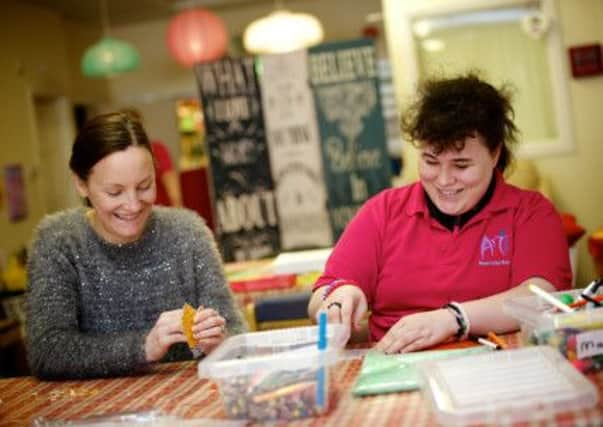ArtSpace celebrates two years with new facilities


Located in a former tile showhouse close to a DIY store, the team behind ArtSpace have transformed the building into something of a safe haven for people from across County Londonderry and farther afield with special needs.
For the past two years, ArtSpace has operated an art studio for adults with learning disabilties to express themselves creatively and learn new skills in the process.
Advertisement
Hide AdAdvertisement
Hide AdNow though, the Eglinton-based community facility has been fitted out with cutting edge equipment for people with special needs to make use of the latest ‘multi-sensory’ support.


As Martina Bell, managing director of ArtSpace, explains, multi-sensory learning is vitally important for people with learning disabilities because it can enable them to use their personal areas of strength to help them learn. Martina explains how multi-sensory learning can include stimulating visual reasoning and learning, auditory techniques, tactile or touch-based learning and kinesthetic or movement-based learning.
Speaking to the Sentinel, Martina said: “ArtSpace is a community interest company based in Eglinton and there are three phases within ArtSpace. Phase one is the art studio. The art studio offers up to 12 places for adults with learning disability and that’s their day opportunities. Our medium is about creativity and it is about developing skills leading to employability.
“We aim to be as progressive as possible around the arts - we don’t want to remain sort of stagnant or dated in what we do with the clients so we are always looking for updated and new, fresh innovative approaches to keeping people stimulated and busy. That’s that in a nutshell.
Advertisement
Hide AdAdvertisement
Hide Ad“Phase two would be the coffee shop and that’s Rosie’s. Rosie’s is positioned right in the middle of the building here at ArtSpace. Rosie’s is, again, part of the community interest company. It is a cafeteria, coffee shop setting offering a service to the clients who attend ArtSpace art studio but also to the public as well. They can come in and have a cup of coffee or a panini. It is important here at ArtSpace that we are inclusive and that people are coming in and using the service and that we are engaging with the public on a regular basis.


It is important that people with special needs are not segregated so that’s part of the aim within Rosie’s as well as the ArtSpace studio.
“Phase three then is the multi-sensory and play area which is under the same roof - the rooms have just recently been installed. That would become a community facility and we will be opening in the not too distant future. We have two multi-sensory studios there and a soft play room. Again, the main focus there is to provide a service for anyone with special needs - from nought to ninety basically - and people with brain injury or older people. It is for anyone who would have a need for multi-sensory stimulation. It is also there for general relaxation, or fun. It is a wide, wide agenda down there.
“The key is making the best use of the specialist equipment that we have. We have three rooms down there.
Advertisement
Hide AdAdvertisement
Hide AdWe have the personal space, which is about giving people time to chill out and relax within a multi-sensory environment. We have a water bed there, we have fiber optics, we have projection and lovely soft music. We also aim to bring in reflexologists and aromatherapists to offer an additional service down there.


“Another room is the multi-sensory interactive room. That is quite a large space. It is designed to be as interactive as is physically possible. All of the equipment is switchable and the rationale behind that is to develop skills. It is important that the people who come in here to use these rooms are leaving having learnt something and that it is not just about coming in and chilling out for an hour. It is also about developing skills. The type of skills we would be looking at within a multi-sensory interactive environment is cause and effect, all of the communication bits such as eye tracking and eye scanning.
“The third room is the soft play room. The soft play, whilst it is widely available within the community, they have always been in the field with special needs. The reason why we use soft play is that it is a safe environment for children who have, for instance, mobility issues, epilepsy, behavioural issues, ADHD - you can let off steam without any real risks. What we have done is we have added another dimension around the interactivity so it is important that whenever they are in there playing they are able to switch off and on lights, use the ball pools with the ball pool showers and so on.”